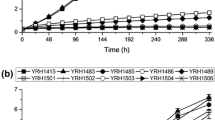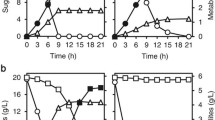Abstract
The purpose of this study was to help lay the foundation for further development of xylose-fermentingSaccharomyces cerevisiae yeast strains through an approach that combined metabolic engineering and random mutagenesis in a recombinant haploid strain that overexpressed only two genes of the xylose pathway. Previously,S. cerevisiae strains, overexpressing heterologous genes encoding xylose reductase, xylitol dehydrogenase and the endogenousXKS1 xylulokinase gene, were randomly mutagenised to develop improved xylose-fermenting strains. In this study, two gene cassettes (ADH1 p -PsXYL1-ADH1 T andPGK1 p -PsXYL2-PGK1 T ) containing the xylose reductase (PsXYL1) and xylitol dehydrogenase (PsXYL2) genes from the xylose-fermenting yeast,Pichia stipitis, were integrated into the genome of a haploidS. cerevisiae strain (CEN.PK 2-1D). The resulting recombinant strain (YUSM 1001) over-expressing theP. stipitis XYL1 andXYL2 genes (but not the endogenousXKS1 gene) was subjected to ethyl methane sulfonate (EMS) mutagenesis. The resulting mutants were screened for faster growth rates on an agar medium containing xylose as the sole carbon source. A mutant strain (designated Y-X) that showed 20-fold faster growth in xylose medium in shake-flask cultures was isolated and characterised. In anaerobic batch fermentation, the Y-X mutant strain consumed 2.5-times more xylose than the YUSM 1001 parental strain and also produced more ethanol and glycerol. The xylitol yield from the mutant strain was lower than that from the parental strain, which did not produce glycerol and ethanol from xylose. The mutant also showed a 50% reduction in glucose consumption rate. Transcript levels ofXYL1, XYL2 andXKS1 and theGPD2 glycerol 3-phosphate dehydrogenase gene from the two strains were compared with real-time reverse transcription polymerase chain reaction (RT-PCR) analysis. The mutant showed 10–40 times higher relative expression of these four genes, which corresponded with either the higher activities of their encoded enzymes or by-product formation during fermentation. Furthermore, no mutations were observed in the mutant’s promoter sequences or the open reading frames of some of its key genes involved in carbon catabolite repression, glycerol production and redox balancing. The data suggest that the enhancement of the xylose fermentation properties of the Y-X mutant was made possible by increased expression of the xylose pathway genes, especially theXKS1 xylulokinase gene.
Similar content being viewed by others
References
Ansell R., Granath K., Hohmann S., Thevelein J.M., Adler L. (1997). The two isoenzymes for yeast NAD+-dependent glycerol-3-phosphate dehydrogenase encoded byGPD1 andGPD2 have distinct roles in osmo-adaptation and redox regulation. EMBO J., 16: 128–132.
Attfield P.V., Bell P.J. (2006). Use of population genetics to derive nonrecombinantSaccharomyces cerevisiae strains that grow using xylose as a sole carbon source. FEMS Yeast Res., 6: 862–868.
Ausubel F.M., Brent R., Kingson R.E., Moore D.D., Seidman J.G., Smity J.A., Struhl K. (1995). Current Protocols in Molecular Biology. John Wiley and Sons, New York, USA.
Bailey J.E., (1991). Toward a science of metabolic engineering. Science, 252:1668–1675.
Bakker B.M., Overkamp K.M., van Maris A.J., Kötter P., Luttik M.A., van Dijken J.P., Pronk J.T. (2001). Stoichiometry and compartmentation of NADH metabolism inSaccharomyces cerevisiae. FEMS Microbiol. Rev., 25: 15–37.
Björkqvist S., Ansell R., Adler L., Lidén G. (1997). Physiological response to anaerobicity of glycerol-3-phosphate dehydrogenase mutants ofSaccharomyces cerevisiae. Appl. Environ. Microbiol., 63: 128–132.
Bleve G., Rizzotti L., Dellaglio F., Torrian, S. (2003). Development of reverse-transcription (RT)-PCR and real time RT-PCR assays for rapid detection and quantification of viable yeasts and molds contaminating yogurts and pasteurized food products. Appl. Environ. Microbiol., 69: 4116–4122.
Bruinenberg P.M., de Bot P.H.M., van Dijken J.P., Scheffers W.A. (1984). NADH-linked aldose reductase: the key to anaerobic alcoholic fermentation of xylose by yeasts. Appl. Microbiol. Biotechnol., 19: 256–260.
Chiang L.C., Gong C.S., Chen L.F., Tsao G. (1981). D-Xylulose fermentation bySaccharomyces cerevisiae. Appl. Environ. Microbiol., 42: 284–289.
Christensen L.H., Schulze U., Nielsen J., Villadsen J. (1995). Acoustic off-gas analyzer for bioreactors: precision, accuracy and dynamics of detection. Chem. Eng. Sci., 50: 2601–2610.
Divol B., Miot-Sertier C., Lonvaud-Funel A. (2006). Genetic characterization of strains ofSaccharomyces cerevisiae responsible for ‘refermentation’ inBotrytis-affected wines. J. Appl. Microbiol., 100: 516–526.
Eliasson A., Christensson C., Wahlbom C.F., Hahn-Hägerdal B. (2000). Anaerobic xylose fermentation by recombinantSaccharomyces cerevisiae carryingXYL1, XYL2, andXKS1 in mineral medium chemostat cultures. Appl. Environ. Microbiol., 66: 3381–3386.
Eliasson A., Hofmeyr J-H. S., Pedler S., Hahn-Hägerdal B. (2001). The xylose reductase/xylitol dehydrogenase/xylulokinase ratio affects product formation in recombinant xyloseutilisingSaccharomyces cerevisiae. Enzyme Microb. Technol., 29: 288–297.
Entian K.D., Kötter P. (1998). Yeast mutant and plasmid collections. In: Brown A.J.P., Tuite M.F., Eds, Yeast Gene Analysis, Vol. 26, Academic Press, London, United Kingdom, pp. 431–449.
Gietz D., St. Jean A., Woods R.A., Schiestl R.H. (1992). Improved method for high efficiency transformation of intact yeast cells. Nucleic Acids Res., 20: 1425.
Giuletti A., Overbergh L., Valckx D., Decallonne B., Bouillon R., Mathieu C. (2001). An overview of real-time quantitative PCR: applications to quantify cytokine gene expression. Methods, 25: 386–401.
Hallborn J., Walfridsson M., Airaksinen U., Ojamo H. Hahn-Hägerdal B., Penttilä M., Keränen S. (1991). Xylitol production by recombinantSaccharomyces cerevisiae. Biotechnology, 9: 1090–1095.
Ho N.W., Chen Z., Brainard A.P. (1998). Genetically engineeredSaccharomyces yeast capable of effective cofermentation of glucose and xylose. Appl. Environ. Microbiol., 64: 1852–1859.
Jeppsson H., Yu S., Hahn-Hägerdal B. (1996). Xylulose and glucose fermentation bySaccharomyces cerevisiae in chemostat culture. Appl. Environ. Microbiol., 62: 1705–1709.
Jeppsson M., Träff K., Johansson B., Hahn-Hägerdal B., Gorwa-Grauslund M-F. (2003). Effect of enhanced xylose reductase activity on xylose consumption and product distribution in xylose-fermenting recombinantSaccharomyces cerevisiae. FEMS Yeast Res., 3: 167–175.
Jin Y.S., Ni H., Laplaza J.M., Jeffries T.W. (2003). Optimal growth and ethanol production from xylose by recombinantSaccharomyces cerevisiae require moderate D-xylulokinase activity. Appl. Environ. Microbiol., 69: 495–503.
Johansson B., Christensson C., Hobley T., Hahn-Hägerdal B. (2001). Xylulokinase overexpression in two strains ofSaccharomyces cerevisiae also expressing xylose reductase and xylitol dehydrogenase and its effect on fermentation of xylose and lignocellulosic hydrolysate. Appl. Environ. Microbiol., 67: 4249–4255.
Karhumaa K., Hahn-Hägerdal B., Gorwa-Grauslund M-F. (2005). Investigation of limiting metabolic steps in the utilization of xylose by recombinantSaccharomyces cerevisiae using metabolic engineering. Yeast, 22: 359–368.
Karhumaa K., Fromanger R., Hahn-Hägerdal B., Gorwa-Grauslund M-F. (2007). High activity of xylose reductase and xylitol dehydrogenase improves xylose fermentation by recombinantSaccharomyces cerevisiae. Appl. Microbiol. Biotechnol., 73: 1039–1046.
Kostrzynska M., Sopher C.R., Lee H. (1998). Mutational analysis of the role of the conserved lysine-270 in thePichia stipitis xylose reductase. FEMS Microbiol. Lett., 159: 107–112.
Kötter P., Amore R., Hollenberg C.P., Ciriacy M. (1990). Isolation and characterization of thePichia stipitis xylitol dehydrogenase gene,XYL2, and construction of a xylose-utilizingSaccharomyces cerevisiae transformant. Curr. Genet., 18: 463–500.
Kötter P., Ciriacy M. (1993). Xylose fermentation bySaccharomyces cerevisiae. Appl. Microbiol. Biotechnol., 38: 776–783.
Kuyper M., Winkler A.A., van Dijken J.P., Pronk J.T. (2004). Minimal metabolic engineering ofSaccharomyces cerevisiae for efficient anaerobic xylose fermentation: a proof of principle? FEMS Yeast Res., 4: 655–664.
Lynd L.R. (1996). Overview and evaluation of fuel ethanol from cellulosic biomass: technology, economics, the environment, and policy. Annu. Rev. Energy. Environ., 21: 403–465.
Lynd L.R., Weimer P.J., van Zyl W.H., Pretorius I.S. (2002). Microbial cellulose utilization: fundamentals and biotechnology. Microbiol. Mol. Biol. Rev., 66: 506–577.
Pfaffl M.W. (2001). A new mathematical model for relative quantification in real-time RT-PCR. Nucleic Acids Res., 29: 2002–2007.
Ramakers C., Ruijter J.M., Deprez R.H., Moorman A.F. (2003). Assumption-free analysis of quantitative real-time polymerase chain reaction (PCR) data. Neurosci. Lett., 339: 62–66.
Richard P., Toivari M.H., Penttilä M. (2000). The role of xylulokinase inSaccharomyces cerevisiae xylulose catabolism. FEMS Microbiol. Lett., 190: 39–43.
Rigoulet M., Aguilaniu H., Avéret N., Bunoust O., Camougrand N., Grandier-Vazeille X., Larsson C., Pahlman I-L., Manon S., Gustafsson L. (2004) Organization and regulation of the cytosolic NADH metabolism in the yeastSaccharomyces cerevisiae. Mol. Cell. Biochem., 256/257: 73–81.
Rizzi M., Erlemann P., Bui-Thanh N.-A., Dellweg H. (1988). Xylose fermentation by yeasts. 4. Purification and kinetic studies of xylose reductase fromPichia stipitis. Appl. Microbiol. Biotechnol., 29: 148–154.
Rizzi M., Harwart K., Erlemann P., Bui-Thahn N.-A., Dellweg. H. (1989). Purification and properties of the NAD+-xylitol-dehydrogenase from the yeastPichia stipitis. J. Ferment. Bioeng., 67: 20–24.
Rozen S., Skaletsky H.J. (2000). Primer3 on the WWW for general users and for biologist programmers. In: Krawetz S., Misener S., Eds, Bioinformatics Methods and Protocols: Methods in Molecular Biology, Humana Press, Totowa, NJ, pp. 365–386.
Salusjärvi L., Poutanen M., Pitkänen J.P., Koivistoinen H., Aristidou A., Kalkkinen N., Ruohonen L., Penttilä M. (2003). Proteome analysis of recombinant xylose-fermentingSaccharomyces cerevisiae. Yeast, 20: 295–314.
Sauer U. (2001). Evolutionary engineering of industrially important microbial phenotypes. Adv. Biochem. Eng. Biotechnol., 73: 129–169.
Senac T., Hahn-Hägerdal B. (1990). Intermediary metabolite concentrations in xylulose- and glucose-fermentingSaccharomyces cerevisiae cells. Appl. Environ. Microbiol., 56: 120–126.
Sherman F., Fink G.R., Hicks J. (1991). Methods in Yeast Genetics. Cold Spring Harbor Laboratory Press, Cold Spring Harbor, New York, USA.
Sonderegger M., Sauer U. (2003). Evolutionary engineering ofSaccharomyces cerevisiae for anaerobic growth on xylose. Appl. Environ. Microbiol., 69: 1990–1998.
Sonderegger M., Jeppsson M., Hahn-Hägerdal B., Sauer U. (2004). Molecular basis for anaerobic growth ofSaccharomyces cerevisiae on xylose, investigated by global gene expression and metabolic flux analysis. Appl. Environ. Microbiol., 70: 2307–2317.
Tantirungkij M., Nakashima N., Seki T., Yoshida T. (1993). Construction of xylose-assimilatingSaccharomyces cerevisiae. J. Ferment. Bioeng., 75: 83–88.
Thanvanthri Gururajan V., Pretorius I.S., Cordero Otero R.R. (2007). Molecular cloning and functional expression of a novelNeurospora crassa xylose reductase inSaccharomyces cerevisiae in the development of a xylose fermenting strain. Ann. Microbiol., 57 (1): 223–231.
Toivari M.H., Aristidou A., Rouhonen L., Penttilä M. (2001). Conversion of xylose to ethanol by recombinantSaccharomyces cerevisiae: importance of xylulokinase (XKS1) and oxygen availability. Metabol. Eng., 3: 236–249.
Toivari M.H., Salusjärvi L., Ruohonen L., Penttilä M. (2004). Endogenous xylose pathway inSaccharomyces cerevisiae. Appl. Environ. Microbiol., 70: 3681–3686.
Träff K.L., Jonsson L.J., Hahn-Hägerdal B. (2002). Putative xylose and arabinose reductases inSaccharomyces cerevisiae. Yeast, 19: 1233–1241.
Träff-Bjerre K.L., Jeppsson M., Hahn-Hägerdal B., Gorwa-Grauslund M-F. (2004). Endogenous NADPH-dependent aldose reductase activity influences product formation during xylose consumption in recombinantSaccharomyces cerevisiae. Yeast, 21: 141–150.
Valadi A., Granath K., Gustafsson L., Adler L. (2004). Distinct intracellular localization of Gpd1p and Gpd2p, the two yeast isoforms of NAD+-dependent glycerol-3-phosphate dehydrogenase, explains their different contributions to redox-driven glycerol production. J. Biol. Chem., 279: 39677–39685.
Verduyn C., van Kleef R., Frank J., Schreuder H., van Dijken J.P., Scheffers W.A. (1985). Properties of the NAD(P)H-dependent xylose reductase from the xylose-fermenting yeastPichia stipitis. Biochem. J., 226: 664–677.
Verduyn C., Postma E., Scheffers W.A., van Dijken J.P. (1992). Effect of benzoic acid on metabolic fluxes in yeasts: a continuous-culture study on the regulation of respiration and alcoholic fermentation. Yeast, 8: 501–517.
Wahlbom C.F., van Zyl W.H., Jonsson L.J., Hahn-Hägerdal B., Otero R.R. (2003a). Generation of the improved recombinant xylose-utilizingSaccharomyces cerevisiae TMB 3400 by random mutagenesis and physiological comparison withPichia stipitis CBS 6054. FEMS Yeast Res., 3: 319–326.
Wahlbom C.F., Cordero Otero R.R., van Zyl W.H., Hahn-Hägerdal B., Jonsson L.J. (2003b). Molecular analysis of aSaccharomyces cerevisiae mutant with improved ability to utilize xylose shows enhanced expression of proteins involved in transport, initial xylose metabolism, and the pentose phosphate pathway. Appl. Environ. Microbiol., 69: 740–746.
Walfridsson M., Anderlund M., Bao X., Hahn-Hägerdal B. (1997). Expression of different levels of enzymes fromPichia stipitis XYL1 andXYL2 genes inSaccharomyces cerevisiae and its effects on product formation during xylose utilization. Appl. Microbiol. Biotechnol., 48: 218–224.
Wang P.Y., Schneider H. (1980). Growth of yeasts on D-xylulose 1. Can. J. Microbiol., 26: 1165–1168
Author information
Authors and Affiliations
Corresponding author
Rights and permissions
About this article
Cite this article
Thanvanthri Gururajan, V., Van Rensburg, P., Hahn-Hägerdal, B. et al. Development and characterisation of a recombinantSaccharomyces cerevisiae mutant strain with enhanced xylose fermentation properties. Ann. Microbiol. 57, 599–607 (2007). https://doi.org/10.1007/BF03175361
Received:
Accepted:
Issue Date:
DOI: https://doi.org/10.1007/BF03175361




